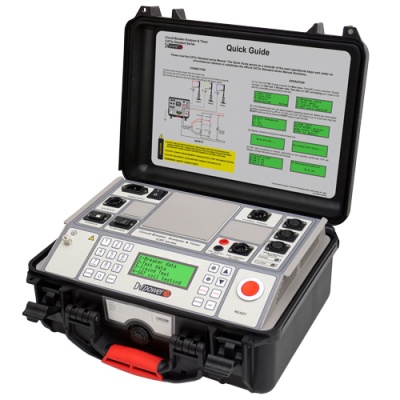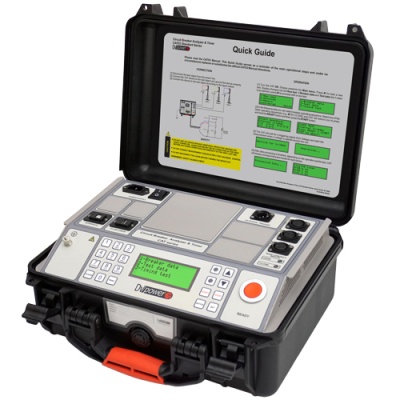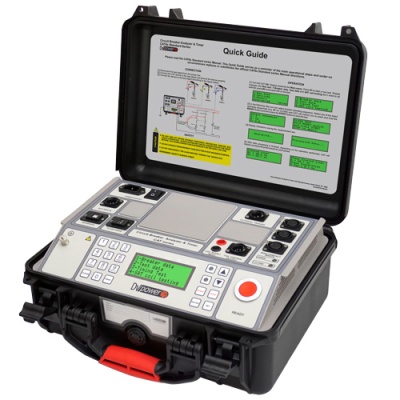Dynamic Resistance Measurement (DRM) of Circuit Breaker Contacts
Introduction The design of an arcing chamber in modern high-voltage puffer-type SF6 gas circuit breakers is based on the operation of the two parallel contact sets, as shown in Figure 1. The low-resistance silver-plated contacts, or the main contacts, are specifically designed to carry the load current without any excessive temperature rise while the breaker is in the closed position. During the circuit breaker opening operation, main contacts separate first. Following the main contact part, the tungsten–copper arcing contacts are finally opened, thus initiating arc quenching and circuit interruption.
Introduction
The design of an arcing chamber in modern high-voltage puffer-type SF6 gas circuit breakers is based on the operation of the two parallel contact sets, as shown in Figure 1. The low-resistance silver-plated contacts, or the main contacts, are specifically designed to carry the load current without any excessive temperature rise while the breaker is in the closed position. During the circuit breaker opening operation, main contacts separate first. Following the main contact part, the tungsten–copper arcing contacts are finally opened, thus initiating arc quenching and circuit interruption. The arcing contact is designed to take the brunt of the arcing during closing and opening operations. The right side of the below picture illustrates the fixed part of the contact with the blue nozzle and the left side is the moving contact. The blue nozzle directs the pressurized SF6 gas toward the arc which catches on the arcing contacts.

The arcing contact is the first to make a contact during a close operation and the last to break contact during an open operation. The circuit breaker will have the arcing contact wear under normal operation as well as when breaking the circuit under a short-circuit current. If the arcing contact is too short or in a poor condition, then the breaker soon becomes unreliable.
It should be remembered that excessive arcing-contact wear and/or misalignment might result in decreasing the circuit breaker’s breaking capacity because of changing the arcing contact surface that causes reducing dielectric strength. Main contact surfaces can be deteriorated by arcing resulting in increased resistance, excessive heating, and in worst-case, complete failure.
Contact Resistance Measurement
To assess the condition of the breaker contacts, the main contact resistance measurement is usually performed. However, the static resistance measured when the breaker remains in a closed position does not give any indication of the arcing contacts state. To evaluate their condition, an internal inspection can be done, but time-consuming and costly maintenance procedures must be undertaken in order to securely handle the SF6 gas and arc byproducts.
Dynamic resistance measurement (DRM) of circuit breaker contacts was developed to assess the condition of the arcing contacts without dismantling a breaker. It is known as an effective technique for assessing the condition of the power circuit breaker main contacts and arcing contacts. DRM method measures variations in the contact resistance during a breaker operation. Actually, the contact resistance is measured dynamically over an opening or closing operation. DRM has a number of applications. On certain types of breakers, DRM can be used to measure arcing contact lengths reduction. When breaker contact motion is measured simultaneously with a resistance, results can be used to determine the loss of the arcing contact length.
DRM test is performed by injecting a high current through the breaker contact and simultaneously monitoring the voltage drop across the breaker contact as well as current flow during the operation of the breaker. Current should be at least 100 A to provide a higher voltage drop to allow easier detection of the arcing contact potential failures. DRM test requires the circuit breaker analyzer with a good measurement resolution and built-in micro ohmmeter (such as CAT35, CAT36, CAT65, CAT66, CAT125, or CAT126). For a full DRM test, two signals must be recorded:
- voltage drop (VD) across the breaker contacts;
- breaker contact travel curve.
Since the resistance is important for analysis, it is calculated for each sample by Ohm’s law as RINST=VDC/IDC. RINST represents instantaneous resistance values. That means the injected current (IDC) also needs to be measured. Dynamic resistance curve as a function of the time is generated on the basis of these instantaneous resistance values obtained for each sample.
Dynamic Resistance Measurement Curve
In order to extract all diagnostic parameters related to the condition of the arcing contact, the dynamic resistance curve and motion curve should be plotted simultaneously and overlapped (as shown for an opening operation in Figure 2), or the resistance curve should be plotted as a function of the contact travel (as shown in Figure 3). These graphs are generated by DV-Win software. If needed to see values at ordinate for all mentioned curves, then the view presented in Figure 4 is suitable for that. To enable this view it is needed to select option Switch view in the DV-Win in options above the graph.

The resistance curve starts as a straight line before the breaker starts to move (Figure 2, 3, and 4). This represents the main contact resistance. As the contact starts to move, small fluctuations of the main contact resistance can appear (can be seen easier in Figure 3). When the main contacts separate, there is a spike in the resistance curve (because higher resistance of the arcing contact) and after that, the arcing contact resistance can be measured. When the resistance goes to infinity, it means the breaker is open.
The resistance curve as a function of contact travel can be used to reveal failures related to arcing contact position. For example, the highest spike of the resistance curve in Figure 3. indicates a change in the arcing contact condition. Spike can appear in the resistance curve due to transition, but in that case, it is a short-term event. Since this spike is a long-term event, it indicates a bad contact or contact bounce at the opening.
The most important diagnostic parameters (extracted in Figure 2) that are used to assess the condition of the main and arcing contacts are:
- Arcing contact wipe (overlapping distance)
- Arcing contact overlapping time.
These parameters can be used to determine a length condition of the arcing contact, i.e. to measure a length reduction of the arcing contact. In cases when the contact motion is not recorded (becomes impossible to determine Arcing contact wipe), Arcing contact overlapping time can be useful to assess the condition of the breaker contacts, especially when reference values are obtained from a manufacturer or from a commissioning test.
DV-Win software automatically calculates above stated diagnostic parameters.


To download .pdf format of this article, please log in and visit the following link. Literature and copyrights are stated in the original document.




